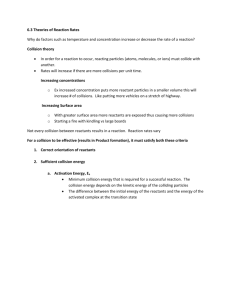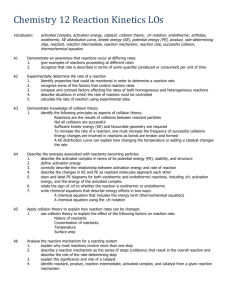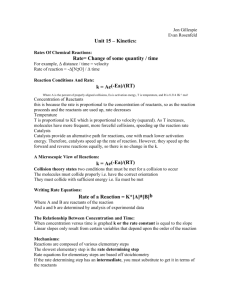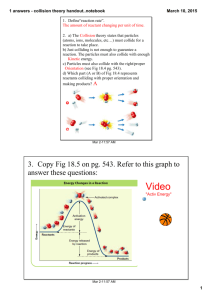Kinetics and Equilibrium
advertisement
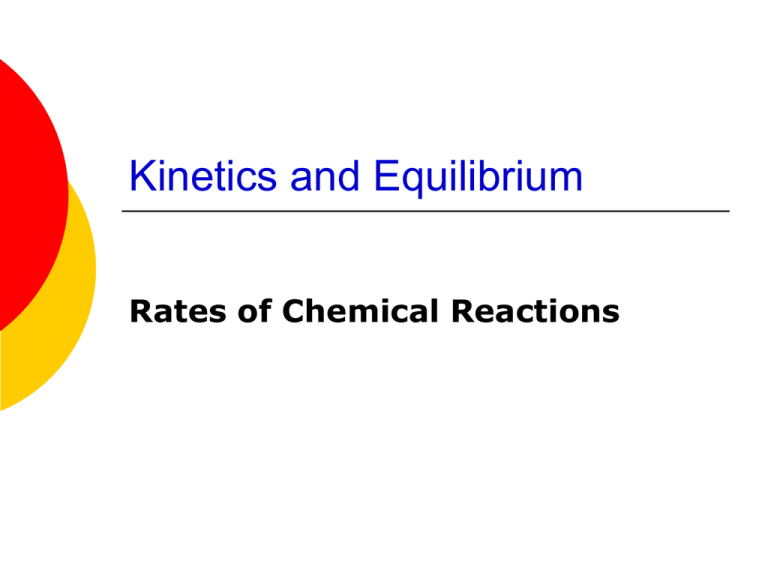
Kinetics and Equilibrium Rates of Chemical Reactions Expressing Reaction Rates The change in the amount of reactants or products over time is called the reaction rate or rate of reaction. Expressing Reaction Rates When a reaction occurs between gaseous species or in solution, the reaction rate is expressed as a change in the concentration of the reactant or product per unit time. The concentration of a compound (in mol/L) is symbolized by placing square brackets, [ ], around the chemical formula. Factors that affect Reaction Rate 1. 2. 3. 4. 5. The rate of a reaction can be increased by increasing the temperature. Increasing the concentrations of the reactants usually increases the rate of the reaction. Increasing the available surface area of a reactant increases the rate of a reaction. A catalyst is a substance that increases the rate of a reaction. The catalyst is regenerated at the end of the reaction and can be re-used. The rate of a chemical reaction depends on what the reactants are. In other words, the reactivity of the reactants has a major impact on reactant rate. Section Review: P 467, #1,2,3,4,5 Theories of Reaction Rates kinetic molecular theory All matter is made up of microscopic-sized particles (atoms, molecules, ions). These particles are in constant motion, because they possess kinetic (movement) energy. There are spaces between the particles of matter. The speed and spacing determine the physical state of matter. Adding heat increases the speed of the moving particles, thus increasing their kinetic energy, as well as the space they occupy. Collision Theory In order for a reaction to occur, reacting particles (atoms, molecules, or ions) must collide successfully with one another. If a collision is necessary for a reaction to occur, then the rate of the reaction will increase if there are more collisions per unit time. Collision Theory and Concentration greater concentration: increases the number of collisions between the particles per second. decreasing the concentration of reactants decreases the reaction rate. If the particles are gaseous, increasing the pressure has the same effect as increasing the concentration, because the same mass of particles is confined to a smaller volume. Collision Theory and Surface Area When a solid undergoes a chemical reaction, collisions can occur only at the solid’s surface. For example, if you want to make a campfire, you will likely start with paper and small twigs, rather than with logs. The paper and twigs provide a greater surface area, which enables more collisions to occur. Collision Theory and the Nature of Reactants Reactions that involve ionic compounds and simple ions are generally faster than reactions involving molecular compounds. Reactions that involve breaking weaker bonds are generally faster than reactions that involve breaking stronger bonds. Reactions that involve breaking fewer bonds are generally faster than reactions that involve breaking a greater number of bonds. Collision Theory and Temperature Increasing the temperature of a reaction results in an increase in the reaction rate. At higher temperatures, particles move more quickly, so they have greater kinetic energy and collide more frequently. Activation Energy In order for a collision to result in a chemical reaction, the particles must collide with enough energy to break bonds in the reactants and start to form bonds in the products. The activation energy, Ea, of a reaction is the minimum collision energy that is required for a successful reaction. Reactions and Orientation of Reactants Reacting particles must collide with the proper orientation in relation to one another. This is also known as having the correct collision geometry. Video Summary For a collision between reactants to result in a reaction, the collision must satisfy both of these two criteria: correct orientation of reactant particles sufficient collision energy When both of these criteria are met, a collision is said to be effective. Only effective collisions result in the formation of products. Transition State Theory Transition state theory is used to explain the transition, or change, from reactants to products. The kinetic energy of the reactants is transferred to potential energy as the reactants collide, due to the law of conservation of energy. Transition State Theory You can represent the increase in potential energy during a chemical reaction using a potential energy diagram: a diagram that charts the potential energy of a reaction against the progress of the reaction. The y-axis represents potential energy. The x-axis, labelled “Reaction progress,” represents the progress of the reaction through time. The “hill” in each diagram illustrates the activation energy barrier of the reaction. A slow reaction has a high activation energy barrier. A fast reaction, by contrast, has a low activation energy barrier. Potential Energy Diagrams The top of the activation energy barrier on a potential energy diagram represents the transition state of the reaction. The chemical species that exists at the transition state is referred to as the activated complex. The activated complex is a transitional species that exists for a fraction of a moment and is neither product nor reactant. Practice P 467 1-4 Elementary Reactions A reaction mechanism is a series of steps that make up an overall reaction. Each step, called an elementary reaction, involves a single molecular event, such as a simple collision between atoms, molecules, or ions. It cannot be broken down into further, simpler steps. Elementary Reactions Reaction Mechanism: Two steps or elementary reactions : 2NO(g) + O2(g) → 2NO2(g) Step 1 NO(g) + O2(g) → NO3(g) Step 2 NO3(g) + NO(g) → 2NO2(g) Adding the two steps gives the overall reaction. Intermediates? Problem Step 1 NO2(g) + NO2(g) → NO3(g) + NO(g) Step 2 NO3(g) + CO(g) → NO2(g) + CO2(g) Write the overall balanced equation for this reaction and identify the reaction intermediate. Practice P 478 #5-8 The Rate-Determining Step Elementary reactions in mechanisms all have different rates. The rate-determining step, is the slowest elementary reaction. So, it determines the overall rate. The Rate-Determining Step Step 1 Bread → Toast (slow, rate-determining) Step 2 Toast + Butter → Buttered toast (fast) Step 1 Bread → Toast (fast) Step 2 Toast + Frozen butter → Buttered toast (slow, rate-determining) Rate determining step 2NO(g) + 2H2(g) → N2(g) + 2H2O(g) Step 1 2NO(g) + H2(g) → N2O(g) + H2O(g) (slow, rate-determining) Step 2 N2O(g) + H2(g) → N2(g) + H2O(g) (fast) Catalysts A catalyst is a substance that increases the rate of a chemical reaction without being consumed by the reaction. A catalyst works by lowering the activation energy of a reaction so that more reactants have sufficient energy to react. It lowers the activation energy by providing an alternative mechanism for the reaction. Catalysts Step 1 Step 2 A + catalyst → Acatalyst Acatalyst + B → AB + catalyst Overall reaction A + B → AB Section Review P 484 #1-12 Chapter Review: P 486 #1-11 and 13 Quiz Wednesday


